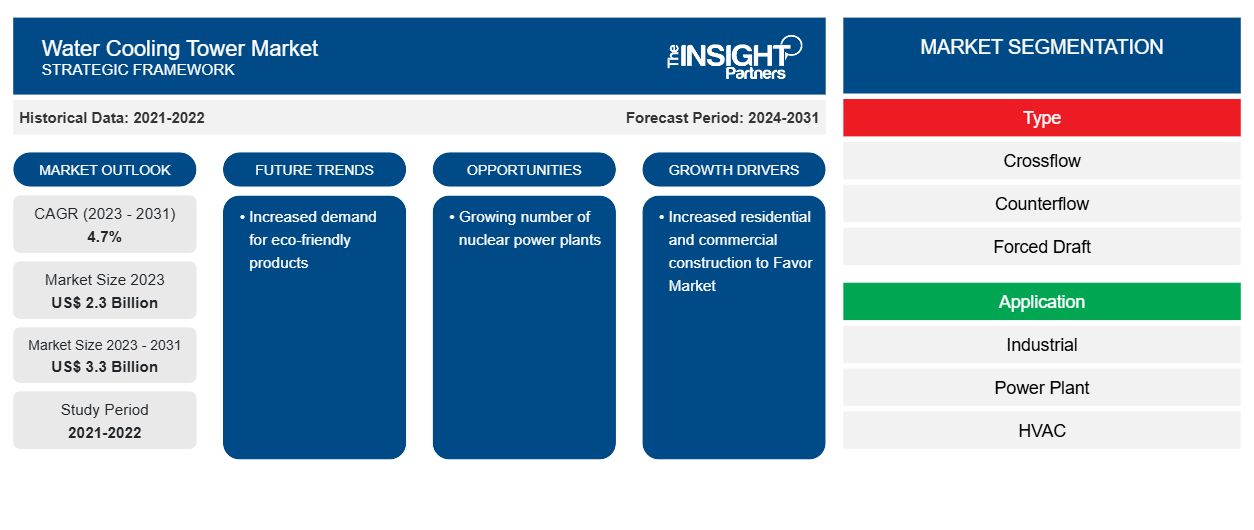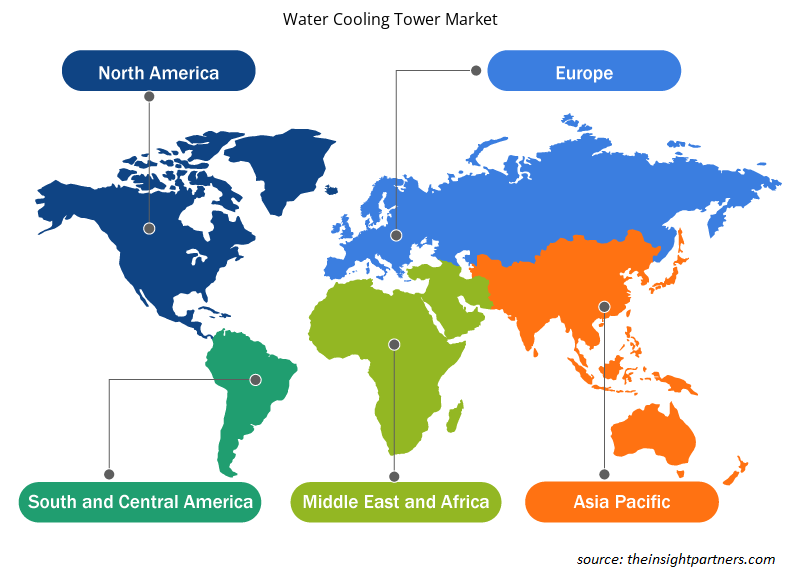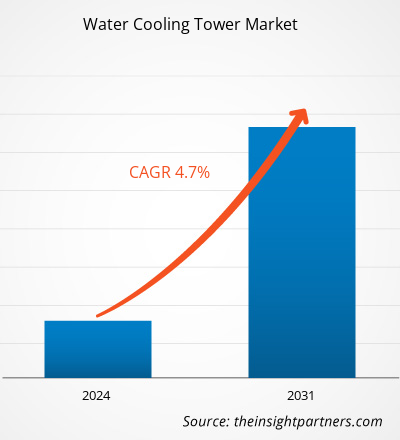The Water Cooling Tower market size is projected to reach US$ 3.3 billion by 2031 from US$ 2.3 billion in 2023. The market is expected to register a CAGR of 4.7% during 2023–2031. With growing concerns over sustainability and reducing the carbon footprint, the demand for eco-friendly products for water tower cooling has increased. Thus, increased sustainability is likely to remain a key trend in the market.
Water Cooling Tower Market Analysis
The demand for water cooling towers has increased in the power sector. As the demand for energy is growing, the spending on the construction of power plants and, thus, the overall number of power plants has increased in the past few years. For instance, as per the data published by the US government, the country is focusing on building 55% more power plants in 2024 compared to 2023. Such construction spending in the power sector is driving the demand for the water cooling tower market.
Water Cooling Tower Market Overview
In 2023, North America accounted for a notable market share of the global water cooling tower market. Countries such as the US and Canada are leading the North American water cooling tower market. One of the factors that is driving the market is strong industrial growth. Data centers require a strong cooling system to maintain operational efficiency. Thus, many of the data centers are installed with cooling towers to maintain the temperature. Cooling towers in the data centers use air and water to transfer the heat of the data centers. These cooling systems have greater efficiency over the traditional air cooling methods, lower operational costs and flexibility. As per the data by Cloudscene, the US has approximately 5400 data centers in the US. Thus, owing to the presence of a vast number of data centers, the demand for water cooling towers has increased in the past few years.
Customize This Report To Suit Your Requirement
You will get customization on any report - free of charge - including parts of this report, or country-level analysis, Excel Data pack, as well as avail great offers and discounts for start-ups & universities
Water Cooling Tower Market: Strategic Insights

- Get Top Key Market Trends of this report.This FREE sample will include data analysis, ranging from market trends to estimates and forecasts.
You will get customization on any report - free of charge - including parts of this report, or country-level analysis, Excel Data pack, as well as avail great offers and discounts for start-ups & universities
Water Cooling Tower Market: Strategic Insights

- Get Top Key Market Trends of this report.This FREE sample will include data analysis, ranging from market trends to estimates and forecasts.
Water Cooling Tower Market Drivers and Opportunities
Increased residential and commercial construction to Favor Market
Commercial and residential constructions are growing rapidly owing to significant urbanization and industrialization. Approximately more than 93% of the total buildings are residential and commercial construction; in addition, approximately 85% of the total buildings' square feet are dedicated to residential and commercial construction. With such higher penetration of residential and commercial construction, the demand for HVAC systems has increased, ultimately driving the water cooling tower market.
Growing number of nuclear power plants
As the requirement for the energy is increasing, the demand of the nuclear power plants is increasing. Further, owing to increased awareness of carbon emissions, the focus on nuclear power plants has increased as they are more efficient and effective. As per the data published by the Nuclear Energy Institute, in the US, approximately 471 million metric tons of carbon is prevented by using nuclear power plants. In addition, as of now, nuclear power sources are contributing to 10% of the world’s electricity. Hence, governments across the globe are increasing the contribution of nuclear power plants by building more power plants. For instance, as per the data published by the World Nuclear Association, there are 60 nuclear power plants under construction. Thus, increased demand for nuclear power plants is projected to generate notable revenue opportunities in the coming years.
Water Cooling Tower Market Report Segmentation Analysis
Key segments that contributed to the derivation of the Water Cooling Tower market analysis are type and application.
- Based on type, the Water Cooling Tower market is divided into crossflow, counterflow, forced draft, induced draft, and others. The cross-flow segment held a larger market share in 2023.
- By application, the market is segmented into industrial, power plant, and HVAC. The industrial segment held a notable share of the market in 2023.
Water Cooling Tower Market Share Analysis by Geography
The geographic scope of the Water Cooling Tower market report is mainly divided into five regions: North America, Asia Pacific, Europe, Middle East & Africa, and South & Central America.
Asia Pacific held the dominant market share in the global water cooling tower market. Countries such as China, India, Indonesia, and the Philippines are growing notably. Such growth is leading to increased demand for energy as the industrial sector is growing rapidly. Further, owing to urbanization, the demand for residential and commercial sectors has increased. With such growth in the construction, industrial, and energy sectors, the demand for cost-effective cooling systems increased, ultimately driving the water cooling tower market.
Water Cooling Tower Market Regional Insights
The regional trends and factors influencing the Water Cooling Tower Market throughout the forecast period have been thoroughly explained by the analysts at Insight Partners. This section also discusses Water Cooling Tower Market segments and geography across North America, Europe, Asia Pacific, Middle East and Africa, and South and Central America.

- Get the Regional Specific Data for Water Cooling Tower Market
Water Cooling Tower Market Report Scope
| Report Attribute | Details |
|---|---|
| Market size in 2023 | US$ 2.3 Billion |
| Market Size by 2031 | US$ 3.3 Billion |
| Global CAGR (2023 - 2031) | 4.7% |
| Historical Data | 2021-2022 |
| Forecast period | 2024-2031 |
| Segments Covered |
By Type
|
| Regions and Countries Covered | North America
|
| Market leaders and key company profiles |
Water Cooling Tower Market Players Density: Understanding Its Impact on Business Dynamics
The Water Cooling Tower Market is growing rapidly, driven by increasing end-user demand due to factors such as evolving consumer preferences, technological advancements, and greater awareness of the product's benefits. As demand rises, businesses are expanding their offerings, innovating to meet consumer needs, and capitalizing on emerging trends, which further fuels market growth.
Market players density refers to the distribution of firms or companies operating within a particular market or industry. It indicates how many competitors (market players) are present in a given market space relative to its size or total market value.
Major Companies operating in the Water Cooling Tower Market are:
- Babcock And Wilcox Enterprises
- Inc.
- Baltimore Aircoil Company
- Bell Cooling Towers
- Delta Cooling Towers
- Inc.
Disclaimer: The companies listed above are not ranked in any particular order.

- Get the Water Cooling Tower Market top key players overview
Water Cooling Tower Market News and Recent Developments
The Water Cooling Tower market is evaluated by gathering qualitative and quantitative data post primary and secondary research, which includes important corporate publications, association data, and databases. A few of the developments in the Water Cooling Tower market are listed below:
- Baltimore Aircoil Company (BAC) announces the release of its new TrilliumSeries Adiabatic Cooler. This adiabatic cooler is ideal for applications that demand a combination of energy efficiency and limited water use. BAC’s innovative design maximizes both water and energy efficiency, ultimately minimizing costs. In addition, the TrilliumSeries Cooler is designed to make installation and ongoing maintenance simple. (Source: Baltimore Aircoil Company, Press Release, February 2022)
- Tower Tech, the leading cooling tower manufacturer, is proud to announce its line of cooling towers featuring StormStrong Fiber Reinforced Polymer (FRP) corrosion-resistant technology. The StormStrong cooling towers are capable of handling hurricane-force winds, earthquakes, and weather-related stresses with minimal to no damage. (Source: Tower Tech, Press Release, September 2022)
Water Cooling Tower Market Report Coverage and Deliverables
The “Water Cooling Tower Market Size and Forecast (2021–2031)” report provides a detailed analysis of the market covering below areas:
- Water Cooling Tower market size and forecast at global, regional, and country levels for all the key market segments covered under the scope
- Water Cooling Tower market trends as well as market dynamics such as drivers, restraints, and key opportunities
- Detailed PEST and SWOT analysis
- Water Cooling Tower market analysis covering key market trends, global and regional framework, major players, regulations, and recent market developments
- Industry landscape and competition analysis covering market concentration, heat map analysis, prominent players, and recent developments in the Water Cooling Tower market
- Detailed company profiles
Frequently Asked Questions
Which region dominated the water cooling tower market in 2023?
Asia Pacific dominated the water cooling tower market in 2023
What are the driving factors impacting the water cooling tower market?
Continuous growth in the oil and gas sector is driving the water cooling tower market
Which are the leading players operating in the water cooling tower market?
Babcock And Wilcox Enterprises, Inc., Baltimore Aircoil Company, Bell Cooling Towers, Delta Cooling Towers, Inc., Evapco, Inc., Hamon, Mesan Group, Samco Technologies, Inc., SPX Cooling Technologies, Inc., and Vistech Cooling Systems
What would be the estimated value of the water cooling tower market by 2031?
US$ 3.3 billion estimated value of the water cooling tower market by 2031
What is the expected CAGR of the water cooling tower market?
4.7% is the expected CAGR of the water cooling tower market
- Historical Analysis (2 Years), Base Year, Forecast (7 Years) with CAGR
- PEST and SWOT Analysis
- Market Size Value / Volume - Global, Regional, Country
- Industry and Competitive Landscape
- Excel Dataset
Testimonials
I wish to appreciate your support and the professionalism you displayed in the course of attending to my request for information regarding to infectious disease IVD market in Nigeria. I appreciate your patience, your guidance, and the fact that you were willing to offer a discount, which eventually made it possible for us to close a deal. I look forward to engaging The Insight Partners in the future, all thanks to the impression you have created in me as a result of this first encounter.
DR CHIJIOKE ONYIA, MANAGING DIRECTOR, PineCrest Healthcare Ltd.The Insight Partners delivered insightful, well-structured market research with strong domain expertise. Their team was professional and responsive throughout. The user-friendly website made accessing industry reports seamless. We highly recommend them for reliable, high-quality research services
Yukihiko Adachi CEO, Deep Blue, LLC.Reason to Buy
- Informed Decision-Making
- Understanding Market Dynamics
- Competitive Analysis
- Customer Insights
- Market Forecasts
- Risk Mitigation
- Strategic Planning
- Investment Justification
- Identifying Emerging Markets
- Enhancing Marketing Strategies
- Boosting Operational Efficiency
- Tracking Industry Innovations
- Aligning with Regulatory Trends
Yes! We provide a free sample of the report, which includes Report Scope (Table of Contents), report structure, and selected insights to help you assess the value of the full report. Please click on the "Download Sample" button or contact us to receive your copy.
Absolutely — analyst assistance is part of the package. You can connect with our analyst post-purchase to clarify report insights, methodology or discuss how the findings apply to your business needs.
Once your order is successfully placed, you will receive a confirmation email along with your invoice.
• For published reports: You’ll receive access to the report within 4–6 working hours via a secured email sent to your email.
• For upcoming reports: Your order will be recorded as a pre-booking. Our team will share the estimated release date and keep you informed of any updates. As soon as the report is published, it will be delivered to your registered email.
We offer customization options to align the report with your specific objectives. Whether you need deeper insights into a particular region, industry segment, competitor analysis, or data cut, our research team can tailor the report accordingly. Please share your requirements with us, and we’ll be happy to provide a customized proposal or scope.
The report is available in either PDF format or as an Excel dataset, depending on the license you choose.
The PDF version provides the full analysis and visuals in a ready-to-read format. The Excel dataset includes all underlying data tables for easy manipulation and further analysis.
Please review the license options at checkout or contact us to confirm which formats are included with your purchase.
Our payment process is fully secure and PCI-DSS compliant.
We use trusted and encrypted payment gateways to ensure that all transactions are protected with industry-standard SSL encryption. Your payment details are never stored on our servers and are handled securely by certified third-party processors.
You can make your purchase with confidence, knowing your personal and financial information is safe with us.
Yes, we do offer special pricing for bulk purchases.
If you're interested in purchasing multiple reports, we’re happy to provide a customized bundle offer or volume-based discount tailored to your needs. Please contact our sales team with the list of reports you’re considering, and we’ll share a personalized quote.
Yes, absolutely.
Our team is available to help you make an informed decision. Whether you have questions about the report’s scope, methodology, customization options, or which license suits you best, we’re here to assist. Please reach out to us at sales@theinsightpartners.com, and one of our representatives will get in touch promptly.
Yes, a billing invoice will be automatically generated and sent to your registered email upon successful completion of your purchase.
If you need the invoice in a specific format or require additional details (such as company name, GST, or VAT information), feel free to contact us, and we’ll be happy to assist.
Yes, certainly.
If you encounter any difficulties accessing or receiving your report, our support team is ready to assist you. Simply reach out to us via email or live chat with your order information, and we’ll ensure the issue is resolved quickly so you can access your report without interruption.





















 Get Free Sample For
Get Free Sample For